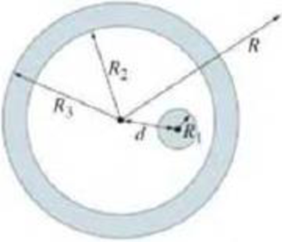
Concept explainers
(II) A very long solid nonconducting cylinder of radius R1 is uniformly charged with charge density ρE. It is surrounded by a cylindrical metal (
FIGURE 22–37 Problem 40.

Want to see the full answer?
Check out a sample textbook solution
Chapter 22 Solutions
EP PHYSICS F/SCI.+ENG.W/MOD..-MOD.MAST.
Additional Science Textbook Solutions
Applications and Investigations in Earth Science (9th Edition)
Campbell Biology in Focus (2nd Edition)
Organic Chemistry (8th Edition)
Chemistry: The Central Science (14th Edition)
Microbiology: An Introduction
Introductory Chemistry (6th Edition)
- Question is attached, thank you.arrow_forwardTwo very small spheres are initially neutral and separated by a distance of 0.612 m. Suppose that 4.12 × 1013 electrons are removed from one sphere and placed on the other. (a) What is the magnitude of the electrostatic force that acts on each sphere? (b) Is the force attractive or repulsive?arrow_forwardEstimate the diameter of the Moon. During a total solar eclipse, the Moon passes in front of the Sun so that during “totality” their apparent sizes match and the Moon blocks light from the Sun shining on the Earth. a) What do you predict the size of the Moon would be if you were to use a pinhole in an aluminum holder, meter stick, and white paper screen to project light from the full Moon through a pinhole onto a screen that is one meter away from the pinhole? b) Describe in detail how you would use this apparatus and your knowledge of pinhole phenomena to estimate the diameter of the Moon. Assume that the distance between the Earth and the Moon is 250,000 miles.arrow_forward
- The following data was collected for a friction experiment in which an object was observed moving at constant speed over a surface. Graph the Applied Force versus the Normal Force and determine the coefficient of friction. Is this value the coefficient of kinetic friction or the coefficient of static friction? Justify your answer. Trial Normal Force Applied Force 1 4.13 1.44 2 6.41 1.68 3 8.94 2.82 4 11.34 3.94 5 13.82 5.05arrow_forward1. Measurements and Linear Regression 1.1 Introduction The objective of this lab assignment is to represent measurement data in graphical form in order to illustrate experimental data and uncertainty visually. It is often convenient to represent experimental data graphically, not only for reporting results but also to compute or measure several physical parameters. For example, consider two physical quantities represented by x and y that are linearly related according to the algebraic relationship, y=mx+b, (1.1) where m is the slope of the line and b is the y-intercept. In order to assess the linearity between y and x, it is convenient to plot these quantities in a y versus x graph, as shown in Figure 1.1. Datapoints Line of regression Figure 1.1: Best fit line example. Once the data points are plotted, it is necessary to draw a "best fit line" or "regression line" that describes the data. A best fit line is a straight line that is the best approximation of the given set of data, and…arrow_forwardPlease help with Statistical Analysis table. These are trials from a Newton's Laws of Motion lab, please help with standard deviation and margin of error. Thanks!arrow_forward
- please solve and answer the question correctly. thank you!!arrow_forwardplease solve and answer the question correctly. thank you!! (hint in 2nd photo)arrow_forwardNewton's Laws of Motion - Please help with the first angle calculations of standard deviation and margin of error. I just need a model and I can figure out the other two angles. Thanks!arrow_forward

 Physics for Scientists and Engineers: Foundations...PhysicsISBN:9781133939146Author:Katz, Debora M.Publisher:Cengage Learning
Physics for Scientists and Engineers: Foundations...PhysicsISBN:9781133939146Author:Katz, Debora M.Publisher:Cengage Learning Principles of Physics: A Calculus-Based TextPhysicsISBN:9781133104261Author:Raymond A. Serway, John W. JewettPublisher:Cengage Learning
Principles of Physics: A Calculus-Based TextPhysicsISBN:9781133104261Author:Raymond A. Serway, John W. JewettPublisher:Cengage Learning College PhysicsPhysicsISBN:9781285737027Author:Raymond A. Serway, Chris VuillePublisher:Cengage Learning
College PhysicsPhysicsISBN:9781285737027Author:Raymond A. Serway, Chris VuillePublisher:Cengage Learning Physics for Scientists and EngineersPhysicsISBN:9781337553278Author:Raymond A. Serway, John W. JewettPublisher:Cengage Learning
Physics for Scientists and EngineersPhysicsISBN:9781337553278Author:Raymond A. Serway, John W. JewettPublisher:Cengage Learning Physics for Scientists and Engineers with Modern ...PhysicsISBN:9781337553292Author:Raymond A. Serway, John W. JewettPublisher:Cengage Learning
Physics for Scientists and Engineers with Modern ...PhysicsISBN:9781337553292Author:Raymond A. Serway, John W. JewettPublisher:Cengage Learning





